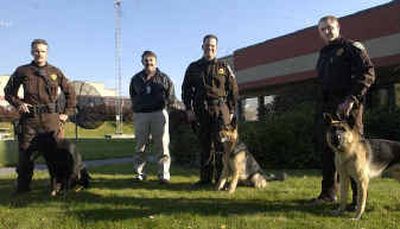Partners and friends

Baron, Chow and Karo don’t understand a lick of English. But speak any number of direct commands in Czechoslovakian, their native language, and each will respond instantly.
Obedience-trained through puppyhood, then expertly cross-trained to patrol, attack, search, and track, these canines along with their handlers, make up the Kootenai County Sheriff’s Department’s three K-9 units.
But unless you’re a night owl or happen to catch a glimpse of a Wednesday afternoon training session, you probably won’t see them around. They patrol primarily at night when the crime rate is highest.
“Nighttime is when all the action takes place,” said Deputy Keith Hutcheson, handler of 9-year-old Baron.
Baron, the oldest of the three dogs, whose specialty is tracking, is a black and tan German shepherd. Imported from Slovakia, where breeding standards are high and bloodlines pure, Baron’s intelligence, his energy level, adaptability, aggression and maturity make him the most beloved, the most social canine in the department, Hutcheson said.
Ferocious yet cuddly, protective yet approachable, Baron displays a dogged loyalty to Hutcheson. And Hutcheson, who exhibits extraordinary control of his canine as well as a unique fondness that is equal to the best of human friendships, says Baron has become an integral part of his family.
Well into their fifth year as a team, Hutcheson and Baron conduct “drug sweeps” in local area schools. Though the amount of narcotics found has decreased in the past year, Hutcheson says the K-9 units will continue the patrols to ensure that schools remain a safe environment for kids. Deputy Jason Shaw has worked with 3-year-old Karo, the youngest of the canines, for the past two years. “The bond we have right now took about a year to build,” said Shaw, who, like Hutcheson does with his dog, lives with Karo seven days a week, 24 hours a day.
That kind of partnership is just beginning for Deputy Rich Lyons and Chow, the third and newest police dog. Following a mandatory one-week bonding period designed to build trust between handler and canine, Lyons and Chow will attend a six-week patrol course that will further cement that bond. After that, a six- to eight-week course in narcotics training will begin.
During the first of the two courses, 5-year-old Chow will learn to instantly respond to Lyons’ commands. And Lyons, a field-training officer prior to his new post, will learn how to handle, train and care for his new partner. Then, when they return, Chow will get to meet the rest of Lyons’ family.
“He can smell and hear them and knows they’re around but won’t be formally introduced until after the first course,” said Lyons.
For canine and handler alike, the ongoing bonding process is vital to their partnership, which, on average, can last as long as seven years, depending on the overall health of the dog.
“When we feel it’s inhumane for the dogs to continue working, we retire them,” Hutcheson said. “It all depends on the number of fights and injuries they have during their careers. Hip and elbow dysplasia is common but we haven’t seen that with our dogs.”
Shepherds, usually a first choice as a patrol/attack dog for many law enforcement agencies, have qualities that set them apart from other breeds. Weighing between 75 and 95 pounds and standing just over 2 feet tall, shepherds’ olfactory abilities are almost 50 times more sensitive than humans – ideal to “sniff out” narcotics.
Commonly known as trotters, shepherds cover a great deal of ground with the minimum number of steps. With a gait that is graceful and coordinated, balanced and powerful, shepherds also have speed and endurance crucial to “attack” and “detain” if necessary.
Baron, Chow and Karo, males left unneutered to maintain their natural aggression, accompany their handlers in the back seat of patrol cars, ever ready when a “call-out” comes.
Usually tipped off by the drug task force, deputies on regular patrol, or by the Coeur d’Alene police, a “call-out” might involve searching an article or building, assisting in a narcotics raid or tracking fleeing suspects or escaped prisoners.
“We rely heavily on the county dogs,” said city police Sgt. Coby Langley. “Because our one canine is primarily a drug-detection dog, we often call on the county to assist when we need to do a building search.”
Hutcheson said that while conducting a search – either a “free search” (in a small area) or a “contained search” (room by room) – a dog breathes about 250 times per minute and needs intermittent breaks. Once the “article” is found, the dog alerts the handler by sitting at his side, rather than barking or growling. It is called “passive alert.”
With a 60 percent “find rate” that far exceeds the national average, the KCSD’s K-9 units can do, in just a few minutes, what it would take five or six deputies two or three hours to accomplish.
The initial cost of each dog is $7,000, plus another $21,000 to cover training costs for both dog and handler. All of the money comes from citizen donations. “The average canine team saves taxpayers an estimated $51,000 a year,” Hutsheson said. “Essentially, the dogs pay for themselves by the end of the first year.”